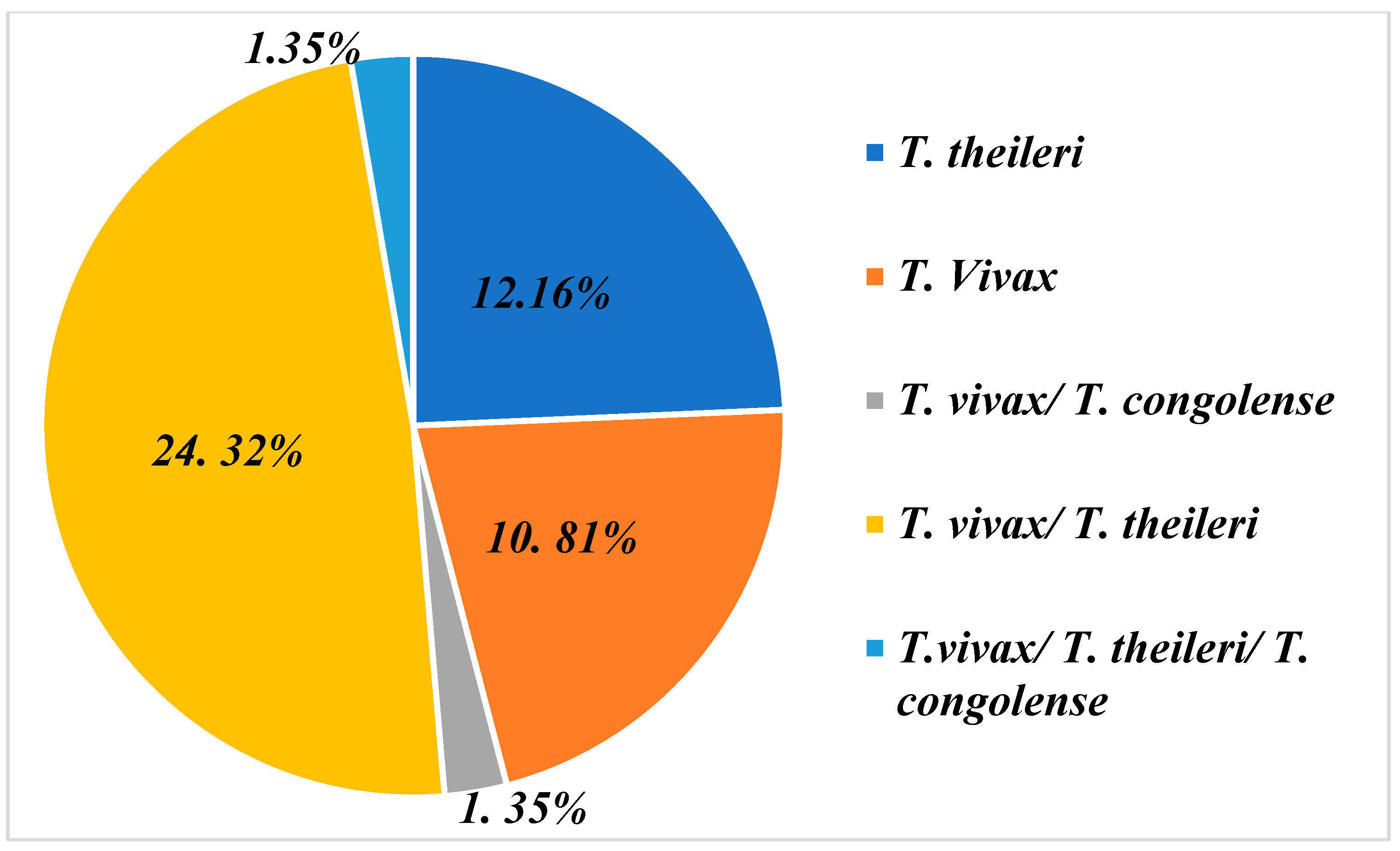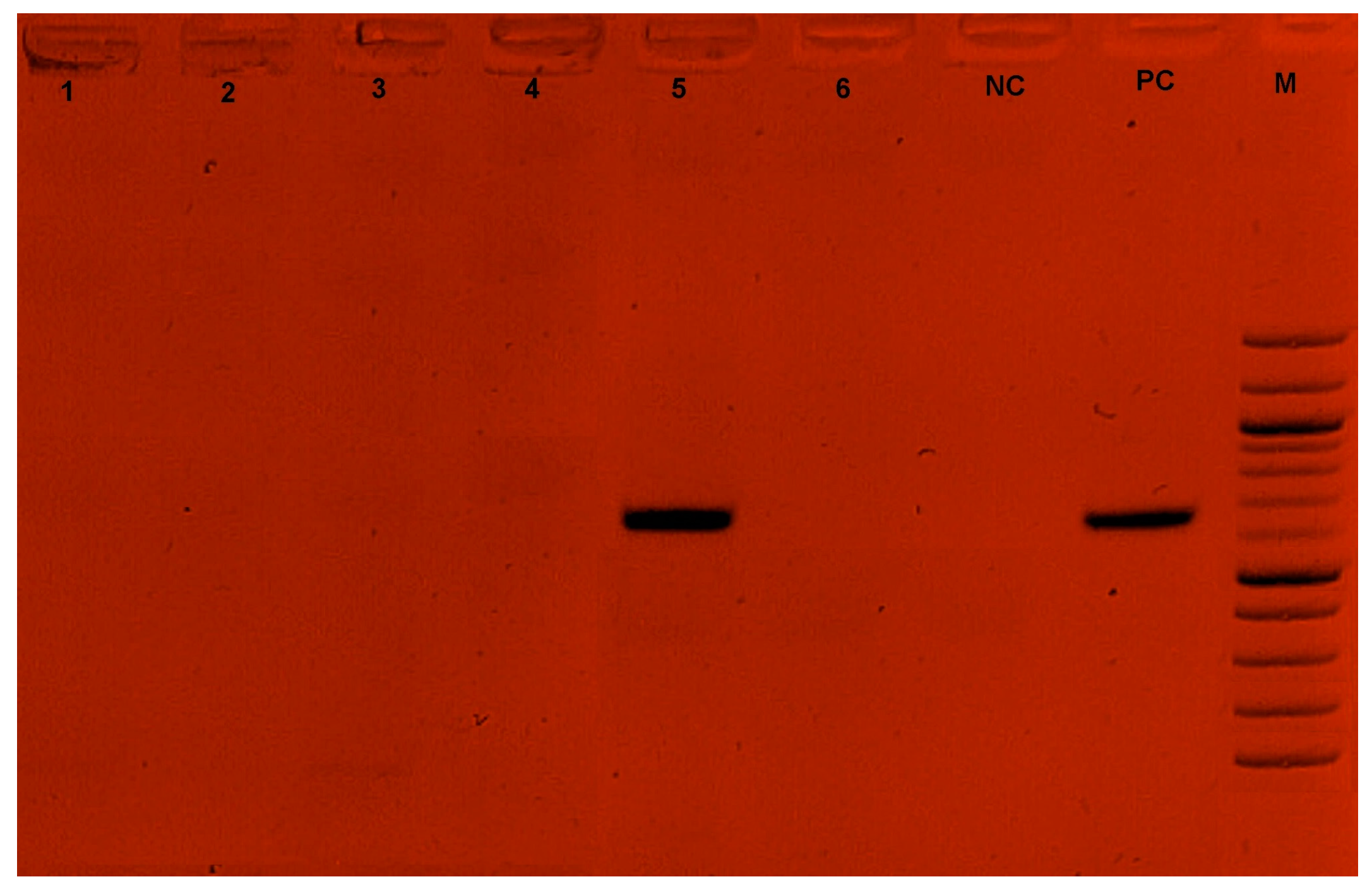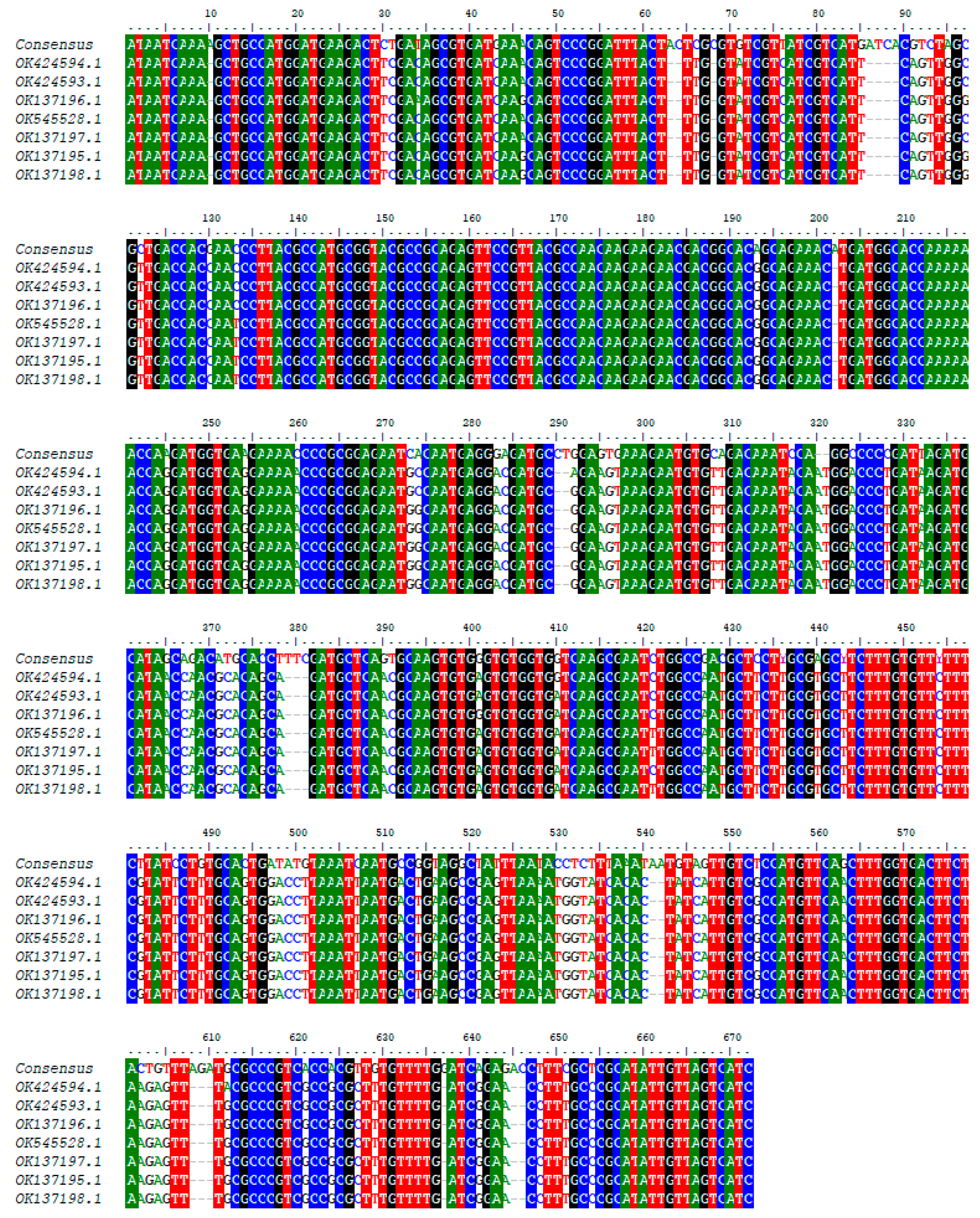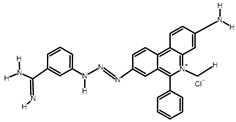Trypanocide Use and Molecular Characterization of Trypanosomes Resistant to Diminazene Aceturate in Cattle in Northern Côte D’Ivoire
Abstract
:1. Background
2. Materials and Methods
2.1. Sample Collection and Interviews with Farmers
2.2. Questionnaire Validation and the Study’s Limitations
2.3. DNA Extraction, Trypanosome Identification and Sequencing of Trypanosome Transporter Genes
2.4. Statistical Analysis and Sequence Analyses
3. Results and Discussion
3.1. Results
3.1.1. Socio-Economic Characteristics of Farmers and General Prophylactic Practices on Visited Farms
| Variables | Modality | Region | Chi-Squared Tests | |||||
|---|---|---|---|---|---|---|---|---|
| Bagoué | Poro | Tchologo | Total | X | df | P | ||
| Farmer’s language | Peulh | 1 (1.37%) | 6 (8.22%) | 7 (9.59%) | 14 (19.18%) | |||
| Senoufo | 24 (32.88%) | 18 (24.66%) | 17 (23.29%) | 59 (80.82%) | 5.78 | 2 | 0.055 | |
| Age | 50–65 years | 12 (16.44%) | 11 (15.07%) | 13 (17.80%) | 36 (49.31%) | |||
| 65–80 years | 13 (17.81%) | 13 (17.81%) | 11 (15.07%) | 37 (50.68%) | 0.36 | 2 | 0.835 | |
| School | Yes | 24 (32.88%) | 14 (19.18%) | 16 (21.92%) | 54 (73.97%) | |||
| No | 1 (1.37%) | 10 (13.70%) | 8 (10.95%) | 19 (26.03%) | 10.02 | 2 | 0.007 | |
| Main activity | Crop grower | 25 (32.87%) | 18 (24.66%) | 17 (23.29%) | 59 (80.82%) | |||
| Breeding | 1 (1.37%) | 6 (8.22%) | 7 (9.59%) | 14 (19.18) | 5.76 | 2 | 0.050 | |
| Type of farm | Sedentary | 25 (34.25%) | 24 (32.88%) | 17 (23.29%) | 66 (90.41%) | |||
| Semi-transhumance | 0 | 0 | 7 (9.59%) | 7 (9.59%) | 15.81 | 2 | 0.001 | |
| Bouvier nationality | Peulh—Burkina Faso | 1 (1.37%) | 0 | 5 (6.85%) | 6 (8.22%) | |||
| Peulh—Mali | 24 (32.88%) | 21 (28.76%) | 19 (26.03%) | 64 (87.67%) | ||||
| Senoufo—Autochtone | 0 | 3 (4.11%) | 0 | 3 (4.11%) | 13.68 | 4 | 0.008 | |
| Injection mode | Intra-muscular | 24 (32.87%) | 16 (21.92%) | 16 (21.92%) | 56 (76.71%) | |||
| Subcutaneous | 0 | 2 (2.74%) | 4 (5.48%) | 6 (8.22%) | ||||
| No injection | 1 (1.37%) | 6 (8.22%) | 4 (5.48%) | 11 (15.07%) | 9.63 | 4 | 0.047 | |
| Injector | Technician | 8 (10.96%) | 8 (10.96%) | 10 (13.70%) | 26 (35.62%) | |||
| Self-medication | 17 (23.28%) | 16 (21.92%) | 14 (19.18%) | 47 (64.38%) | 0.58 | 2 | 0.758 | |
3.1.2. Livestock Farming and Use of Trypanocides
3.1.3. Trypanosome Species Identified on Farms
3.1.4. Molecular Identification of Diminazene Aceturate-Resistant Trypanosomes
3.1.5. Phylogenetic and Sequence Comparison
4. Discussion
5. Conclusions
Author Contributions
Funding
Institutional Review Board Statement
Informed Consent Statement
Data Availability Statement
Acknowledgments
Conflicts of Interest
References
- Tesfaye, D.; Speybroeck, N.; de Deken, R.; Thys, E. Economic Burden of Bovine Trypanosomosis in Three Villages of Metekel Zone, Northwest Ethiopia. Trop. Anim. Health Prod. 2012, 44, 873–879. [Google Scholar] [CrossRef]
- Delespaux, V.; Dinka, H.; Masumu, J.; Van den Bossche, P.; Geerts, S. Five-Fold Increase in Trypanosoma congolense Isolates Resistant to Diminazene Aceturate over a Seven-Year Period in Eastern Zambia. Drug Resist. Updates 2008, 11, 205–209. [Google Scholar] [CrossRef]
- Giordani, F.; Morrison, L.J.; Rowan, T.G.; De Koning, H.P.; Barrett, M.P. The Animal Trypanosomiases and Their Chemotherapy: A Review. Parasitology 2016, 143, 1862–1889. [Google Scholar] [CrossRef] [PubMed]
- Venturelli, A.; Tagliazucchi, L.; Lima, C.; Venuti, F.; Malpezzi, G.; Magoulas, G.E.; Santarem, N.; Calogeropoulou, T.; Cordeiro-Da-silva, A.; Costi, M.P. Current Treatments to Control African Trypanosomiasis and One Health Perspective. Microorganisms 2022, 10, 1298. [Google Scholar] [CrossRef] [PubMed]
- Aregawi, W.G.; Gutema, F.; Tesfaye, J.; Sorsa, A.; Megersa, B.; Teshome, P.; Agga, G.E.; Ashenafi, H. Efficacy of Diminazene Diaceturate and Isometamidium Chloride Hydrochloride for the Treatment of Trypanosoma evansi in Mice Model. J. Parasit. Dis. 2021, 45, 131–136. [Google Scholar] [CrossRef] [PubMed]
- Ngumbi, A.F.; Silayo, R.S. A Cross-Sectional Study on the Use and Misuse of Trypanocides in Selected Pastoral and Agropastoral Areas of Eastern and Northeastern Tanzania. Parasit. Vectors 2017, 10, 607. [Google Scholar] [CrossRef]
- Geerts, S.; Holmes, P.H.; Eisler, M.C.; Diall, O. African Bovine Trypanosomiasis: The Problem of Drug Resistance. Trends Parasitol. 2001, 17, 25–28. [Google Scholar] [CrossRef]
- Talaki, E.; Dao, B.; Kulo, A.E.; N’Feide, T. Enquêtes Entomologique et Parasitologique Sur Les Trypanosomoses Bovines À La Station D’avétonou/Itra, Au Togo. Anim. Health Prod. 2013, 61, 33–38. [Google Scholar]
- Jamal, S.; Sigauque, I.; Macuamule, C.; Neves, L.; Penzhorn, B.L.; Marcotty, T.; Van Den Bossche, P. The Susceptibility of Trypanosoma congolense Isolated in Zambézia Province, Mozambique, to Isometamidium Chloride, Diminazene Aceturate and Homidium Chloride. Onderstepoort J. Vet. Res. 2005, 72, 333–338. [Google Scholar] [CrossRef]
- Mamoudou, A.; Zoli, A.; Tanenbe, C.; Andrikaye, J.P.; Bourdanne, B.; Marcotty, T.; Delespaux, V.; Clausen, P.H.; Geerts, S. Assessment of the Resistance of Cattle Trypanosomes to Diminazene Aceturate and Isometamidium Chloride on the Adamawa Plateau in Cameroon Using a Field Test and a Test in Mice. Rev. DÉlevage Médecine Vét. Pays Trop. 2006, 1, 11–16. [Google Scholar] [CrossRef]
- Simo, G.; Magang, E.M.K.; Mewamba, E.M.; Farikou, O.; Kamga, R.M.N.; Tume, C.; Solano, P.; Ravel, S. Molecular Identification of Diminazene Aceturate Resistant Trypanosomes in Tsetse Flies from Yoko in the Centre Region of Cameroon and Its Epidemiological Implications. Parasite Epidemiol. Control 2020, 9, e00135. [Google Scholar] [CrossRef] [PubMed]
- Yao, L.S.; Gragnon, B.G.; Komoin, C.O.; Bengaly, Z.; Komono, B.D.; Environnement, D.; Abrogoua, U.N.; Abidjan, B.P. Chemoresistance of Trypanosoma vivax (Kinetoplastida: Trypanosomatidae). Int. J. Dev. Res. 2021, 11, 52929–52938. [Google Scholar]
- Tekle, T.; Terefe, G.; Cherenet, T.; Ashenafi, H.; Akoda, K.G.; Teko-Agbo, A.; Van Den Abbeele, J.; Gari, G.; Clausen, P.H.; Hoppenheit, A.; et al. Aberrant Use and Poor Quality of Trypanocides: A Risk for Drug Resistance in South Western Ethiopia. BMC Vet. Res. 2018, 14, 4. [Google Scholar] [CrossRef] [PubMed]
- Vitouley, H.S.; Mungube, E.O.; Allegye-Cudjoe, E.; Diall, O.; Bocoum, Z.; Diarra, B.; Randolph, T.F.; Bauer, B.; Clausen, P.H.; Geysen, D.; et al. Improved Pcr-Rflp for the Detection of Diminazene Resistance in Trypanosoma congolense under Field Conditions Using Filter Papers for Sample Storage. PLoS Negl. Trop. Dis. 2011, 5, e1223. [Google Scholar] [CrossRef]
- Matovu, E.; Stewart, M.L.; Geiser, F.; Brun, R.; Mäser, P.; Wallace, L.J.; Burchmore, R.J.; Enyaru, J.C.; Barrett, M.P.; Kaminsky, R.; et al. Mechanisms of arsenical and diamidine uptake and resistance in Trypanosoma brucei. Eukaryot. Cell 2003, 2, 1003–1008. [Google Scholar] [CrossRef]
- de Koning, H.P.; Anderson, L.F.; Stewart, M.; Burchmore, R.J.; Wallace, L.J.; Barrett, M.P. The trypanocide diminazene aceturate is accumulated predominantly through the TbAT1 purine transporter: Additional insights on diamidine resistance in african trypanosomes. Antimicrob. Agents Chemother. 2004, 48, 1515–1519. [Google Scholar] [CrossRef]
- Stewart, M.L.; Burchmore, R.J.S.; Clucas, C.; Hertz-Fowler, C.; Brooks, K.; Tait, A.; MacLeod, A.; Turner, C.M.R.; De Koning, H.P.; Wong, P.E.; et al. Multiple Genetic Mechanisms Lead to Loss of Functional TbAT1 Expression in Drug-Resistant Trypanosomes. Eukaryot. Cell 2010, 9, 336–343. [Google Scholar] [CrossRef]
- Bridges, D.J.; Gould, M.K.; Nerima, B.; Mäser, P.; Burchmore, R.J.; De Koning, H.P. Loss of the High-Affinity Pentamidine Transporter Is Responsible for High Levels of Cross-Resistance between Arsenical and Diamidine Drugs in African Trypanosomes. Mol. Pharmacol. 2007, 71, 1098–1108. [Google Scholar] [CrossRef]
- Teka, I.A.; Kazibwe, A.J.; El-Sabbagh, N.; Al-Salabi, M.I.; Ward, C.P.; Eze, A.A.; Munday, J.C.; Mäser, P.; Matovu, E.; Barrett, M.P.; et al. The Diamidine Diminazene Aceturate Is a Substrate for the High-Affinity Pentamidine Transporter: Implications for the Development of High Resistance Levels in Trypanosomes. Mol. Pharmacol. 2011, 80, 110–116. [Google Scholar] [CrossRef]
- Delespaux, V.; Chitanga, S.; Geysen, D.; Goethals, A.; Van den Bossche, P.; Geerts, S. SSCP Analysis of the P2 Purine Transporter TcoAT1 Gene of Trypanosoma congolense Leads to a Simple PCR-RFLP Test Allowing the Rapid Identification of Diminazene Resistant Stocks. Acta Trop. 2006, 100, 96–102. [Google Scholar] [CrossRef]
- Ekra, J.Y.; N’goran, E.K.; Mboera, L.E.G.; Gragnon, B.G.; Assovié, K.R.N.; Mafie, E.M. Molecular Epidemiological Survey of Pathogenic Trypanosomes in Naturally Infected Cattle in Northern Côte d’ivoire. Parasites Hosts Dis. 2023, 61, 127–137. [Google Scholar] [CrossRef]
- Auty, H.; Anderson, N.E.; Picozzi, K.; Lembo, T.; Mubanga, J.; Hoare, R.; Fyumagwa, R.D.; Mable, B.; Hamill, L.; Cleaveland, S.; et al. Trypanosome Diversity in Wildlife Species from the Serengeti and Luangwa Valley Ecosystems. PLoS Negl. Trop. Dis. 2012, 6, e1828. [Google Scholar] [CrossRef] [PubMed]
- Percheron, A. Classes d’âge en question. Rev. Française Sci. Polit. 1988, 38, 107–124. [Google Scholar] [CrossRef]
- Thompson, J.D.; Higgins, D.G.; Gibson, T.J. Clustal W: Improving the Sensitivity of Progressive Multiple Sequence Alignment through Sequence Weighting, Position-Specific Gap Penalties and Weight Matrix Choice. Nucleic Acids Res. 1994, 22, 4673–4680. [Google Scholar] [CrossRef]
- Kumar, S.; Stecher, G.; Tamura, K. MEGA7: Molecular Evolutionary Genetics Analysis Version 7.0 for Bigger Datasets. Mol. Biol. Evol. 2016, 33, 1870–1874. [Google Scholar] [CrossRef]
- Tamura, K. Estimation of the Number of Nucleotide Substitutions When There Are Strong Transition-Transversion and G+C-Content Biases. Mol. Biol. Evol. 1992, 9, 678–687. [Google Scholar] [CrossRef] [PubMed]
- Anisimova, M.; Gascuel, O. Approximate Likelihood-Ratio Test for Branches: A Fast, Accurate, and Powerful Alternative. Syst. Biol. 2006, 55, 539–552. [Google Scholar] [CrossRef]
- Saitou, N.; Nei, M. The Neighbor-Joining Method: A New Method for Reconstructing Phylogenetic Trees. Mol. Biol. Evol. 1987, 4, 406–425. [Google Scholar] [CrossRef]
- Felsenstein, J. Confidence Limits on Phylogenies: An Approach Using the Bootstrap. Evolution 1985, 39, 783–791. [Google Scholar] [CrossRef]
- Tamura, K.; Nei, M.; Kumar, S. Prospects for Inferring Very Large Phylogenies by Using the Neighbor-Joining Method. Proc. Natl. Acad. Sci. USA 2004, 101, 11030–11035. [Google Scholar] [CrossRef]
- Akoda, K.; Teko-Agbo, A.; Elh, M.N.; Walbadet, L. Qualité des Médicaments vétérinaires en circulation au Sénégal. Article Original. RASPA 2008, 6, 29–33. [Google Scholar]
- Toure, M. Les Trypanocides et leur utilisation en medecine veterinaire. Rev. D’elevage Med. Vet. Pays Trop. 1973, 26, 113–122. [Google Scholar] [CrossRef]
- Whitesides, E.F. Interactions between Drugs, Trypanosomes and Cattle in the Field. In Drugs, Parasites Hosts; Churchill: London, UK, 1962; pp. 116–141. [Google Scholar]
- Desquesnes, M. Compendium of Diagnostic Protocols of the OIE Reference Laboratory for Animal Trypanosomoses of African Origin OIE Reference Laboratory for Animal Trypanosomoses of African Origin Compendium of Standard Diagnostic Protocols for; CIRAD: Paris, France, 2017; pp. 1–106.
- Kouadio, I.K.; Sokouri, D.; Koffi, M.; Konaté, I.; Ahouty, B.; Koffi, A.; Guetta, S.P.N. Molecular Characterization and Prevalence of Trypanosoma Species in Cattle from a Northern Livestock Area in Côte d’Ivoire. Open J. Vet. Med. 2014, 4, 314–321. [Google Scholar] [CrossRef]
- Acapovi-Yao, G.; Cisse, B.; Koumba, C.R.Z.; Mavoungou, J.F. Infections Trypanosomiennes Chez Les Bovins Dans Des Élevages de Différents Départements En Côte d’Ivoire. Rev. Med. Vet. 2016, 167, 289–295. [Google Scholar]
- Ekra, J.-Y.; N’Goran, E.K.; Mboera, L.E.G.; Mafie, E.M. Prevalence of Bovine Trypanosomiasis in Côte d’Ivoire: Systematic Review and Meta-Analysis. Onderstepoort J. Vet. Res. 2023, 90, 2069. [Google Scholar] [CrossRef] [PubMed]
- Carruthers, L.V.; Munday, J.C.; Ebiloma, G.U.; Steketee, P.; Jayaraman, S.; Campagnaro, G.D.; Ungogo, M.A.; Lemgruber, L.; Donachie, A.M.; Rowan, T.G.; et al. Diminazene resistance in Trypanosoma congolense is not caused by reduced transport capacity but associated with reduced mitochondrial membrane potential. Mol. Microbiol. 2021, 116, 564–588. [Google Scholar] [CrossRef]
- Okello, I.; Mafie, E.; Nzalawahe, J.; Eastwood, G.; Mboera, L.E.G.; Hakizimana, J.N.; Ogola, K. Trypanosoma congolense Resistant to Trypanocidal Drugs Homidium and Diminazene and Their Molecular Characterization in Lambwe, Kenya. Acta Parasitol. 2023, 68, 130–144. [Google Scholar] [CrossRef]







| Name of Drug | Active Substance | Chemical Structure | Percentage of Users |
|---|---|---|---|
| Veriben and Berenil | Diminazene aceturate |  | 28% (21 farmers) |
| Ethidium bromide | Homidium bromide |  | 14% (10 farmers) |
| Trypamidium-Samorin | Isometamidium chloride |  | 43% (32 farmers) |
| No Trypanocide | No active substance | 15% (11 farmers) | |
| 100% (74 farmers) |
Disclaimer/Publisher’s Note: The statements, opinions and data contained in all publications are solely those of the individual author(s) and contributor(s) and not of MDPI and/or the editor(s). MDPI and/or the editor(s) disclaim responsibility for any injury to people or property resulting from any ideas, methods, instructions or products referred to in the content. |
© 2024 by the authors. Licensee MDPI, Basel, Switzerland. This article is an open access article distributed under the terms and conditions of the Creative Commons Attribution (CC BY) license (https://creativecommons.org/licenses/by/4.0/).
Share and Cite
Ekra, J.-Y.; Mafie, E.M.; Sonan, H.; Kanh, M.; Gragnon, B.G.; N’Goran, E.K.; Srinivasan, J. Trypanocide Use and Molecular Characterization of Trypanosomes Resistant to Diminazene Aceturate in Cattle in Northern Côte D’Ivoire. Trop. Med. Infect. Dis. 2024, 9, 192. https://doi.org/10.3390/tropicalmed9090192
Ekra J-Y, Mafie EM, Sonan H, Kanh M, Gragnon BG, N’Goran EK, Srinivasan J. Trypanocide Use and Molecular Characterization of Trypanosomes Resistant to Diminazene Aceturate in Cattle in Northern Côte D’Ivoire. Tropical Medicine and Infectious Disease. 2024; 9(9):192. https://doi.org/10.3390/tropicalmed9090192
Chicago/Turabian StyleEkra, Jean-Yves, Eliakunda Michael Mafie, Henri Sonan, Michael Kanh, Biégo Guillaume Gragnon, Edouard K. N’Goran, and Jagan Srinivasan. 2024. "Trypanocide Use and Molecular Characterization of Trypanosomes Resistant to Diminazene Aceturate in Cattle in Northern Côte D’Ivoire" Tropical Medicine and Infectious Disease 9, no. 9: 192. https://doi.org/10.3390/tropicalmed9090192
APA StyleEkra, J.-Y., Mafie, E. M., Sonan, H., Kanh, M., Gragnon, B. G., N’Goran, E. K., & Srinivasan, J. (2024). Trypanocide Use and Molecular Characterization of Trypanosomes Resistant to Diminazene Aceturate in Cattle in Northern Côte D’Ivoire. Tropical Medicine and Infectious Disease, 9(9), 192. https://doi.org/10.3390/tropicalmed9090192






